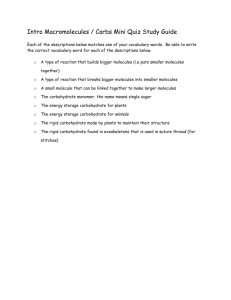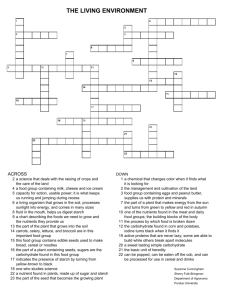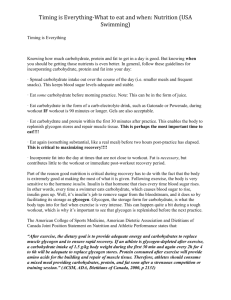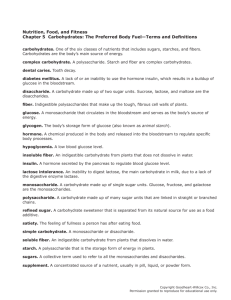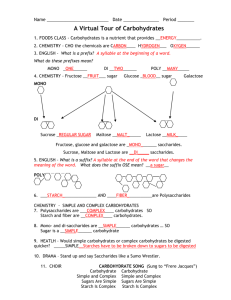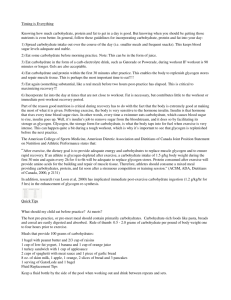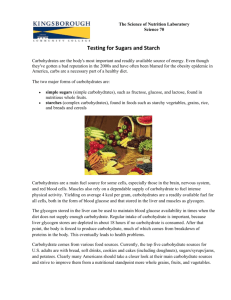General Nutrition Guidelines for Individuals with Diabetes
advertisement
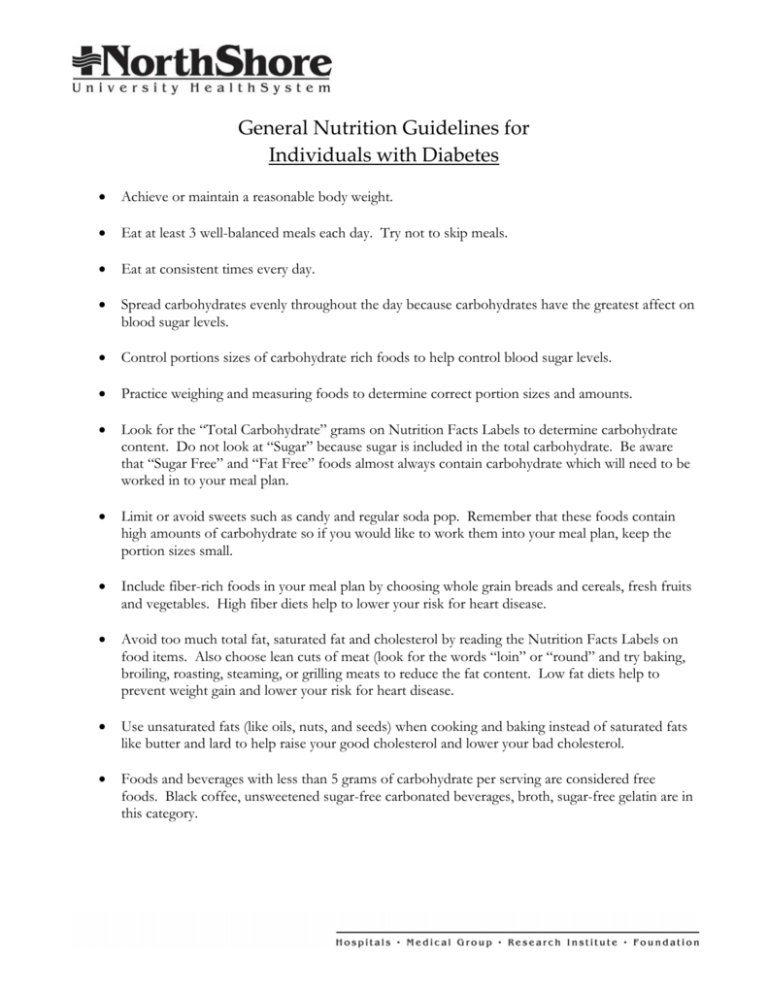
General Nutrition Guidelines for Individuals with Diabetes • Achieve or maintain a reasonable body weight. • Eat at least 3 well-balanced meals each day. Try not to skip meals. • Eat at consistent times every day. • Spread carbohydrates evenly throughout the day because carbohydrates have the greatest affect on blood sugar levels. • Control portions sizes of carbohydrate rich foods to help control blood sugar levels. • Practice weighing and measuring foods to determine correct portion sizes and amounts. • Look for the “Total Carbohydrate” grams on Nutrition Facts Labels to determine carbohydrate content. Do not look at “Sugar” because sugar is included in the total carbohydrate. Be aware that “Sugar Free” and “Fat Free” foods almost always contain carbohydrate which will need to be worked in to your meal plan. • Limit or avoid sweets such as candy and regular soda pop. Remember that these foods contain high amounts of carbohydrate so if you would like to work them into your meal plan, keep the portion sizes small. • Include fiber-rich foods in your meal plan by choosing whole grain breads and cereals, fresh fruits and vegetables. High fiber diets help to lower your risk for heart disease. • Avoid too much total fat, saturated fat and cholesterol by reading the Nutrition Facts Labels on food items. Also choose lean cuts of meat (look for the words “loin” or “round” and try baking, broiling, roasting, steaming, or grilling meats to reduce the fat content. Low fat diets help to prevent weight gain and lower your risk for heart disease. • Use unsaturated fats (like oils, nuts, and seeds) when cooking and baking instead of saturated fats like butter and lard to help raise your good cholesterol and lower your bad cholesterol. • Foods and beverages with less than 5 grams of carbohydrate per serving are considered free foods. Black coffee, unsweetened sugar-free carbonated beverages, broth, sugar-free gelatin are in this category. General Nutrition Guidelines Continued… WHAT IS A CARBOHYDRATE? Carbohydrates are the sugar, starch, and fiber in foods and they are the body’s main energy source. As one of the three “macronutrients” carbohydrates (along with protein and fat) give a food Calories. According to the Dietary Reference Intakes published by the USDA, 45% - 65% of calories should come from carbohydrate. The Five Main Categories of Food that Contain Carbohydrate Are: • Grains – This Category includes: bread, pita, waffles, pancakes, tortillas, cereals, oats, rice, flour, pasta/noodles, buns, rolls, grits, bulgur, muffins, crackers, chips, energy bars popcorn, etc. • Starchy Vegetables – This Category includes: corn, baked beans, lima beans, peas, potatoes, sweet potatoes/yams, lentils, plantains, chickpeas/garbanzo beans, kidney beans, pinot beans, black beans. • Milk and Yogurt – This Category includes: Skim/Fat-free milk, 1% milk, 2% milk, whole milk, soy milk, buttermilk, evaporated milk, kefir, goat’s milk, rice milk etc. and all types of yogurt. • Fruits and Fruit Juice – This Category includes: all fruit and all fruit juices (even light or no sugar added juices) • Sweets – This Category includes: sugar, honey, jelly/jam, syrup, cake, brownies, candy, cookies, doughnuts, fruit cobbler, fruit snacks, ice cream, pudding, gelatin. HOW MUCH SHOULD I EAT? How much carbohydrate you need to eat each day is based upon your physical activity, age, gender, weight goals and nutritional needs. Although everyone has slightly different carbohydrate needs, it is important for all people with diabetes to spread the carbohydrate that they eat evenly throughout the day. Even though carbohydrate increases blood sugar, remember that you need to eat carbohydrate at each meal everyday to feed your cells. WHY DO WE COUNT CARBOHYDRATES 100% of the carbohydrates that we eat turn into blood sugar within 15 minutes to 2 hours after eating. It is important to remember that the total amount of carbohydrate eaten is more important that the source of carbohydrate. This means that a piece of chocolate cake that contains 15 grams of carbohydrate and a slice of whole wheat bread that contains 15g of carbohydrate will have the same affect on your blood sugar. However, portion sizes for sweets are usually smaller because they are more concentrated sources of carbohydrate. For example, 1 tablespoon of honey has the same amount of carbohydrate as 4 ounces of orange juice or a cup of cubed cantaloupe. HOW DO I COUNT CARBOHYDRATES Once you know how many grams of carbohydrate you need each day, you just need to learn the carbohydrate values for the foods you eat to start counting carbohydrates. To learn the carbohydrate content of foods that have a Nutrition Facts Label, look at Total Carbohydrate grams. For foods that do not have a Nutrition Facts Label ask your dietitian about sources for this information.

